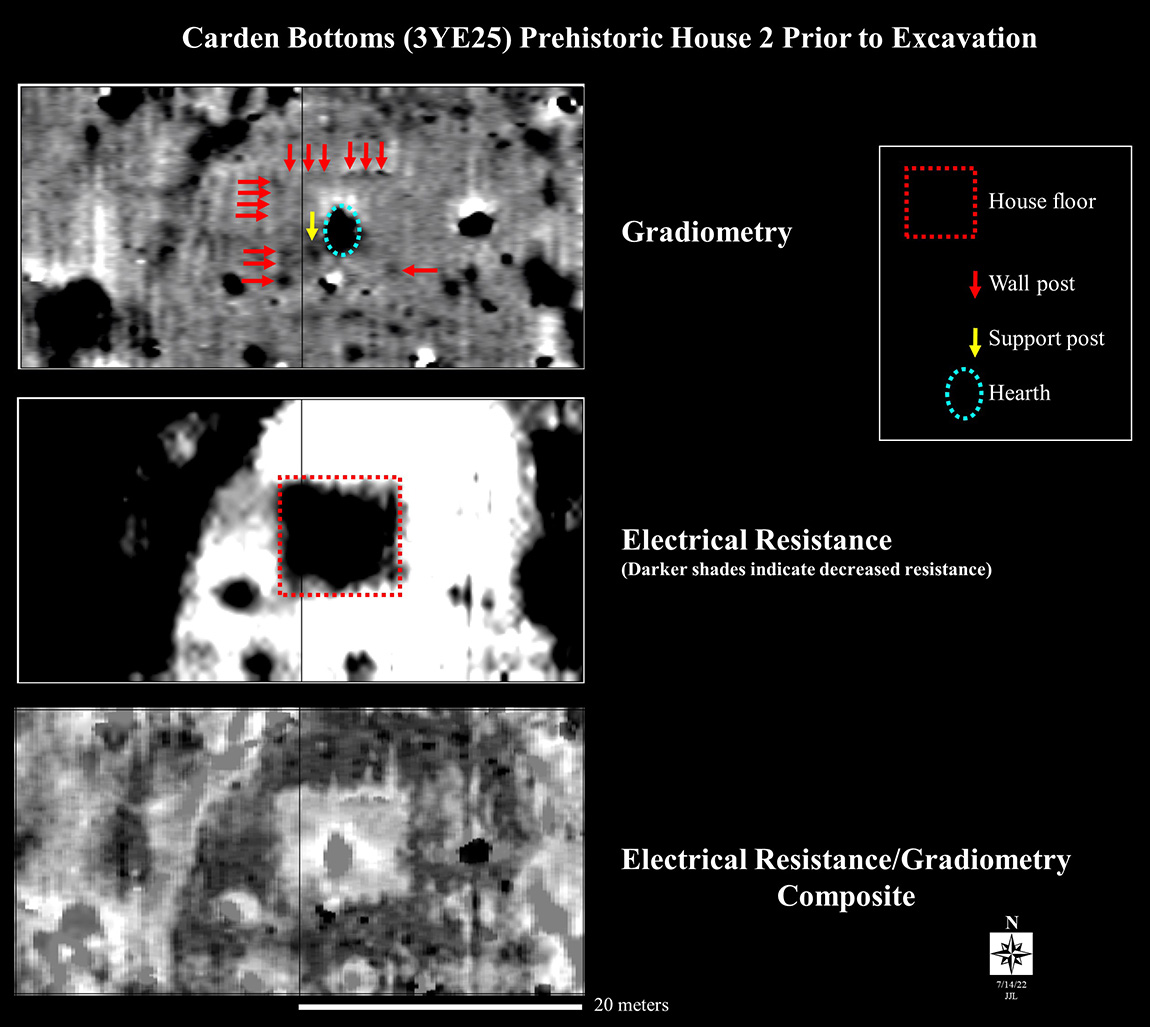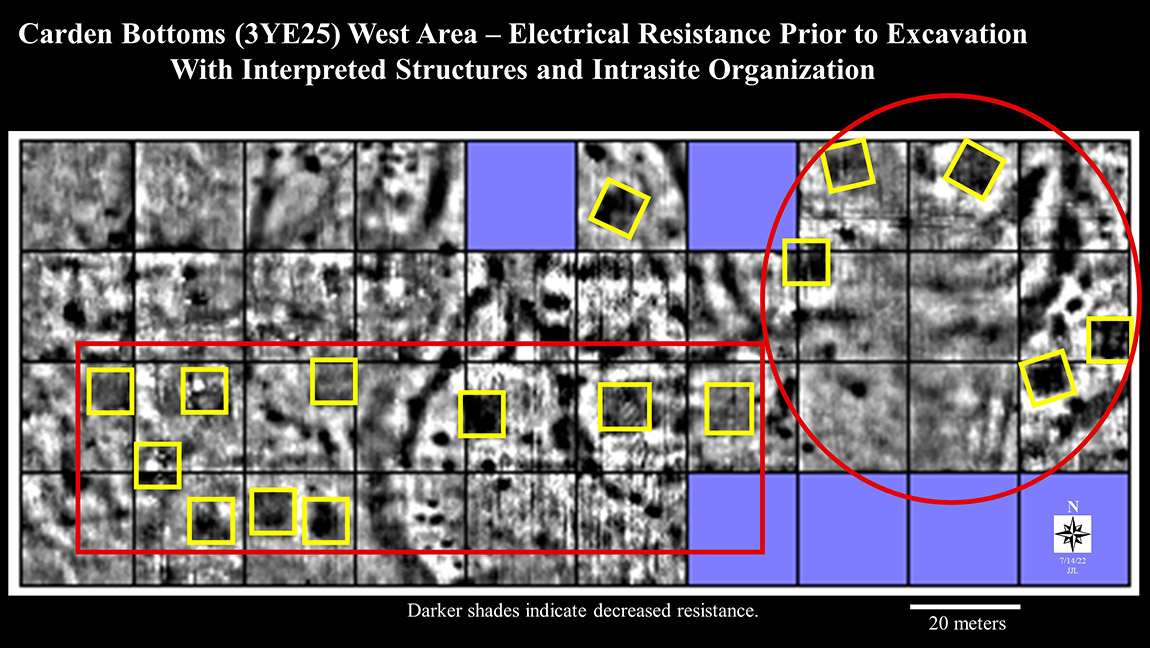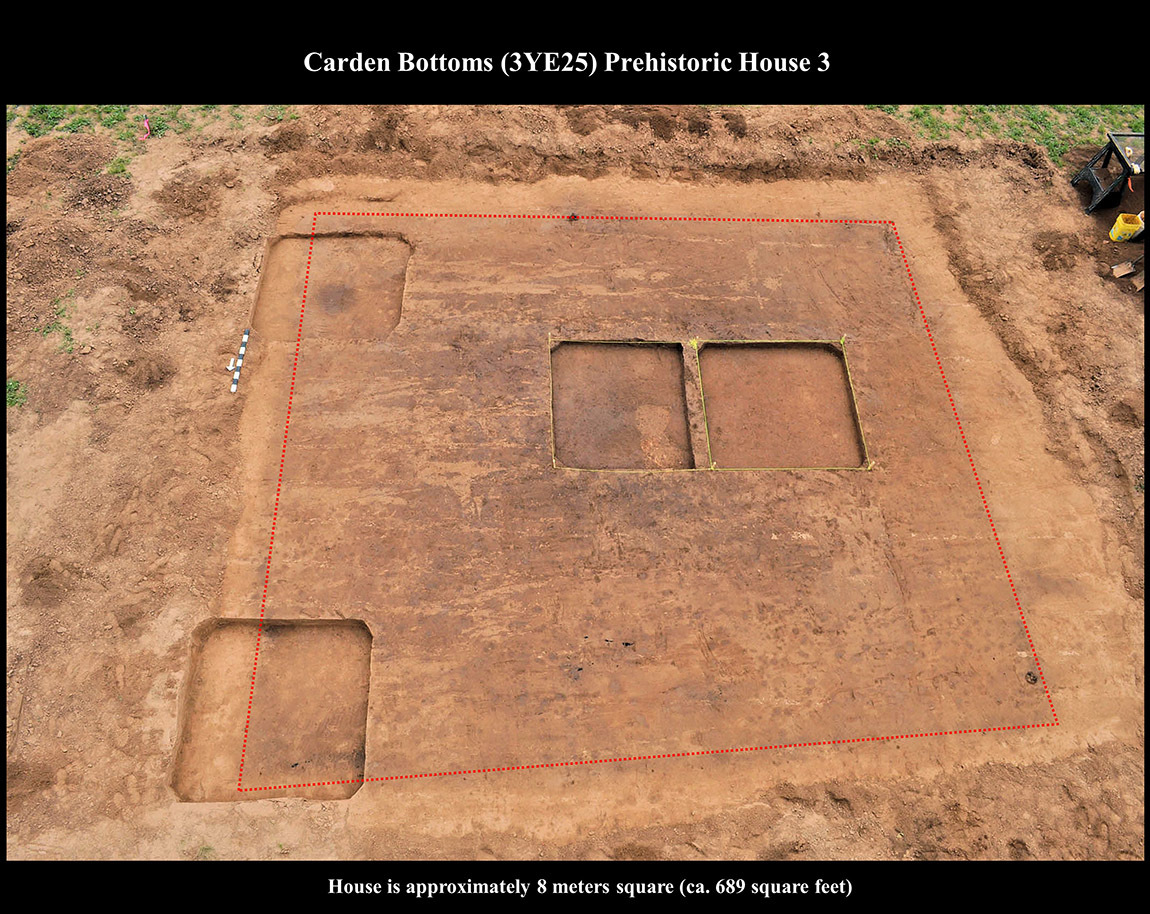
By Gillian (Steeno) Bjornen, Master's student in Anthropology, University of Arkansas Fayetteville
Feature of the Month - August 2022
Carden Bottoms (3YE25) is an Early Contact period site along the Arkansas River which was built, occupied, and subsequently abandoned during the early seventeenth century. The site is particularly noteworthy for its elaborately decorated vessels, which attracted looters during the early twentieth century (Sabo et al. 2020:16). Multiple investigations have focused on the artistic craft and iconography represented on these vessels; they highlight a “mingling of cultures” where locally sourced pottery feature Quapaw, Caddo, and Osage imagery (Clancy 1985, Sabo et al. 2020, Walker 2014, Wiewel 2014). This cultural mingling was likely the result of European contact that ravaged the area and disrupted every aspect of Native American life throughout the Southeast. Communities, like the one formed at Carden Bottoms, likely congregated in order to forge a new way of life in the wake of European contact.
Beginning in 2009, the Arkansas Archeological Survey conducted excavations and surface surveys of possible house features and midden deposits at the site, expanding on Jerry Hilliard’s and Leslie C. Stewart-Abernathy's prior work (Hilliard 1981, Stewart-Abernathy, 1994, Stewart-Abernathy, 2010). This process began with extensive electrical resistance and gradiometric surveys conducted by Dr. Jami J. Lockhart of the ARAS. In Figure 1, the signatures of an individual house floor, wall posts, hearth, and support posts are clearly visible in the darker signatures of the images. On a larger scale, the outlines of house features are present in discrete clusters across the site; these data helped inform which houses were selected for subsequent excavation (Figure 2). Three of these house signatures were excavated; one house was completely damaged because of plowing (Figure 3), but the two others had intact hardened clay floors, post molds, and a unique artifact distribution above the house floor. The excavated houses were 8 m x 8 m with small poles 15–20 cm in diameter placed into the floors (Sabo et al. 2020:21). House 1 (Figure 4) is shown below cross-referencing these gradiometric signatures with the excavated post molds, house floor, and hearth features. There were no overlapping structures, which would indicate a relatively short occupation of the site, one where residents came together briefly to escape harsh threats and then dispersed after about a generation.

One intriguing aspect of the houses at Carden Bottoms are the differences between the floor contexts and the “above floor” contexts. Based on the location of four interior, large posts arranged around a central hearth, evidence suggests that the houses at Carden Bottoms were lofted structures, unlike other wall-trench structures built during the preceding Mississippian period in Arkansas. These central posts were placed 1 m below the house floor, providing solid support for a secondary surface above (Sabo et al. 2020:21). Not only this, but the “above floor” artifact scatter suggests that the artifacts were deposited in an upper sediment layer oriented in a haphazard manner as if they had fallen from the loft when the structure was burned. Furthermore, the De Soto chronicles detail a shift in house design as the entrada moved through, what is thought to be, modern-day Arkansas (Clayton et al. 1995). These accounts provide an ethnohistoric basis for the claims made about the lofted nature of the structure at Carden Bottoms.

Thus, Carden Bottoms houses provide an important point of contrast to Mississippian ways of life in Arkansas and the Southeast. These lofted structures represent a divergence from architectural traditions, one that is also seen in the burial pottery. Investigations into the houses and their associated pit features at Carden Bottoms are ongoing and will be used to inform further research about household responses to European contact in the Arkansas River Valley.

References
Clancy, Phyllis M.
1985 The Carden’s Bottom Puzzle Elucidated. Master’s thesis, Department of Anthropology, University of Arkansas, Fayetteville.
Clayton, Lawrence A., Vernon J. Knight, and Edward C. Moore
1995 The De Soto Chronicles: The Expedition of Hernando de Soto to North America in 1539-1543. University of Alabama Press, Tuscaloosa.
Hilliard, Jerry E.
1981 Archeological Reconnaissance of a Proposed Ditch in Carden Bottom, Yell County, Arkansas. Manuscript on file, Arkansas Archeological Survey, Fayetteville.
Sabo, George, III, Jerry E. Hilliard, Leslie C. Walker, Jami J. Lockhart, Ann M. Early, and Rebecca L.F. Wiewel
2020 Carden Bottoms: Indigenous Responses to Europeans on the Far Reaches of the Mississippian Shatter Zone. In Contact, Colonialism, and Native Communities in the Southeastern United States, edited by Edmond A. Boudreaux III, Maureen Meyers, and Jay K. Johnson, pp. 16-34. University of Florida Press, Gainesville.
Stewart-Abernathy, Leslie C.
1994 The Carden Bottoms Project, Yell County, Arkansas: From Dalton to Trade Beads, So Far. Field Notes: Newsletter of the Arkansas Archeological Society 261:3-7.
2010 Archeology at Carden Bottom, 2009, or, In Search of the People of Cayas. Field Notes: Newsletter of the Arkansas Archeological Society 352:12-13.
Walker, Leslie
2014 Liminal River: Art, Agency and Cultural Transformation Along the Protohistoric Arkansas River. PhD dissertation, Department of Anthropology, University of Arkansas, Fayetteville.
Wiewel, Rebecca
2014 Constructing Community in the Central Arkansas River Valley: Ceramic Compositional Analysis and Collaborative Archeology. PhD dissertation, Department of Anthropology, University of Arkansas, Fayetteville.
Feature of the Month Series
Archeological features are elements or structures that are nonportable or cannot be easily removed from a site (such as a wall or a post hole). Archeologists document archeological features extensively in the field to record what will otherwise be destroyed in the process of excavation. The records of these features are often all that is left at the end of an excavation. Excellent record keeping is necessary for these features to provide insight into the archeological record and site formation.
In this series, we present interesting and important archeological features that have helped archeologists to better or more fully understand the sites on which they were working. New features will be added monthly. Find the list of features here.
